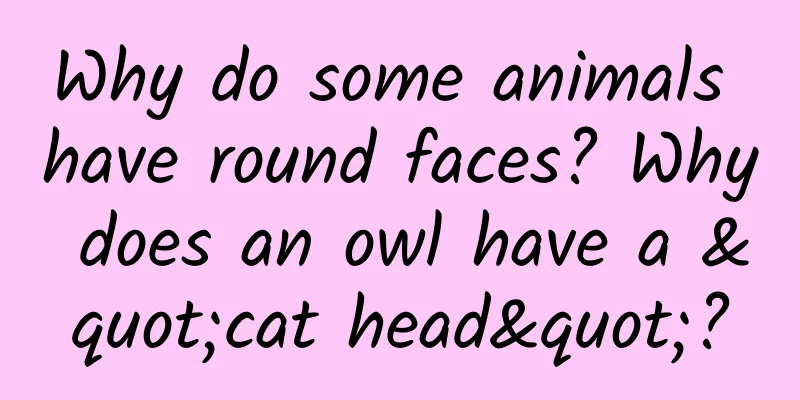Why do some animals have round faces? Why does an owl have a "cat head"?

|
In this world, some animals are loved and paid attention to by people because they have round heads, round faces and big eyes similar to those of human babies. Among them, cats and Strigiformes (That is, an owl) A typical example But have you ever thought about How did they get their round heads? Why do owls have a "cat head"? First of all, the round faces of cats may look short, but in terms of length, they are probably not short faces. For example, the skulls of many lions and tigers are more than 30 cm long, or even longer. This length is much longer than that of foxes, which look long, and also longer than that of humans, who also look round and short. The reason why cats look like they have big round faces is because of their short and thick muzzles and cheekbones. The latter is more precisely the zygomatic arch, which is relatively wide and has a lot of muscles attached to it. The attached muscles, from the outside, just make up their big round faces and thick mouths. The skull of the cat leopard Pantherapardus, with a short snout Image source: animal.memozee.com Small cat with round face, ocelot Photo taken at the National Museum of Zoology Why do cats have such faces and mouths? Because a short and thick snout is beneficial for cats to use the front of their mouth as a lever when hunting alone, providing a stronger bite force. When the bite force reaches a certain level, the canine teeth at the front of the cat's mouth will release powerful force to break the opponent's cervical vertebrae or better lock the throat. In addition, they are attached to the muscle above the zygomatic arch, the temporalis muscle. The temporalis muscle can provide strength to kill the prey at the moment of biting when the cat bites the prey. More temporalis muscles attached are conducive to hunting prey. A model of a lion skull from the cat family, photographed at the Shanghai Natural History Museum The yellow part is the zygomatic arch and canine teeth Today's cats have short and stocky faces, which are designed for individual combat and hunting for delicious meat, but their ancestors were not like this! The ancestor of the cat family - an early member of the Carnivoramorpha, with a relatively long and slender mouth and a body that looks a bit like a civet cat. Early carnivorous species, source: az-animals.com They preyed on small animals with relatively long mouths, and there were more molars and premolars at the back of their mouths. Some of their descendants took the evolutionary path of relying more on carnivorous, instant-kill hunting, and these are the cats. Their mouths became shorter and thicker, and the number of teeth at the back of their mouths decreased a lot, with only about thirty teeth left. In addition to evolving into cats, some of these early carnivorous members also evolved into carnivorous animals that were not so keen on instant kills and did not eat only meat, such as civets and brown bears that eat a combination of meat and vegetables, and the gray wolf (Canis lupus) that likes to continuously attack large prey and occasionally eat fruit. The long skulls of gray wolves and sand foxes. The green part is the approximate position of the molars and premolars at the back of their mouths. Photographed at Tianjin Natural History Museum A brown bear with a long mouth, photographed at the Beijing Zoo These animals have maintained relatively long mouths during evolution. The long mouths can accommodate teeth of different shapes at the back of the mouth, making it easier for them to process a variety of foods. For example, more molars and premolars can be placed at the back to grind up fruits eaten or to chew leftover bones - cats with fewer molars find it difficult to do this. The crab-eating seal (Lobodon carcinophagus) among the Carnivores has evolved the teeth at the back of its mouth into a sieve-like shape to filter seawater and keep the tiny krill in its mouth. The teeth of the crab-eating seal. When it eats the water with the small animals and closes its mouth, the gaps between its teeth allow the water to escape and leave the food behind. Image source: coolantarctica.com Note: With the exception of lions, male cheetahs, and a few other species, the existing cats mainly hunt alone, although there are also small-scale cooperatives. Jaguars like to bite the skulls of their prey when hunting. The Secret of the Owl's "Head" The reason why owls have round faces is not because of their plump muscles, but because of the feathers filling their bodies. If someone shaved an owl's feathers, it would look a bit like a bald chicken. If you see an owl soaked in water, you would also find that its feathers would shrink and its big face would instantly become smaller. So, the owl that looks like it has a big face and a chubby body is actually just puffy. The thick and abundant feathers can even cover the owl's legs, which makes the owl's legs easily appear as short legs even though they are not short. Owls' legs are actually not short. Image source: scienceabc.com What are the purposes of having so many feathers on an owl's face? In 2022, based on relevant research on the great gray owl, the academic community discovered that the large face formed by their feathers is conducive to the transmission of sound, making it easier for them to hear the sounds of prey. The feathers on their faces form radial discs that gather sound waves to amplify the sound and find mice stealing food in the dark. The area of their brain responsible for hearing is more developed, and their feather structure is conducive to silent flight, which is compatible with this configuration of "hearing in all directions". The picture shows a great gray owl. Source: 365daysofbirds.com Of course, there are some owls that don't have a very large face, such as the Northern Eagle Owl (Ninox japonica). These owls don't rely so much on their ears, but rely mainly on their eyesight. They also look more like hawks than those owls with larger faces. Some of these hawk-like owls do not follow the "traditional" route of traveling at night, but also come out during the day. In fact, the owl family also traveled during the day more than 40 to 50 million years ago, just like most eagles today. Fossils from continental Europe and Wyoming, USA are proof of this. The claws of these early owls were also very different from those of today's nocturnal owls. Instead, they were similar to the claws of eagles. However, in the later evolution process, many owls gave up fighting during the day and chose to wake up at night and start hunting under the moonlight, and the shape of their claws also changed. The short-eared owl sometimes "goes out" during the day Photo taken at the National Museum of Zoology Early owl bone fossils found in the United States, source newsroom.taylorandfrancisgroup.com Note: A few owls are active during the day, and the irises of these owls are lighter in color. For example, the Short-eared Owl, the Arctic Snow Owl is also a typical example, and the common Little Owl with Vertical Stripes on its Belly will come out in the early morning and dusk to catch mice. Little Owl specimen with vertical stripes on belly, photographed at the National Museum of Zoology Other big-faced animals Cats and owls aren't the only animals with round faces. Other animals, such as male orangutans, have also evolved round faces. Compared to their female counterparts, male orangutans are heavier and have "bigger faces." The back is supported by a lot of muscle and fat. Below the big face is a huge laryngeal sac, which is a weapon for them to sing love songs. The throat pouch under the big face can sing and make sounds. This is to tell other male orangutans not to get close to themselves. If two male orangutans fall in love with the same person, they will fight to the death. A male orangutan with a big face, photographed at Tianjin Zoo A female orangutan with a small face, photographed at Tianjin Zoo The giant panda, our national treasure, also has a round face and a short snout, with a large number of muscles on its face for biting. However, their round face and short snout are not mainly used to deal with meat, but to bite off hard bamboo. Giant panda skull, photographed at Xining Wildlife Park Dogs are actually a subspecies of gray wolves. Of course, many breeds of dogs, such as the small Yorkshire terrier, Pekingese, French bulldog, etc., are completely different from their wild relatives - their muzzles have become very short, and they also look short and round. This is certainly not to enhance the bite force, but the result of artificial breeding from generation to generation. Such breeding also brings a lot of trouble to the dog's health. For example, the shorter mouth and nose leads to a shorter nasal cavity, which causes respiratory diseases to become a major concern for these breeds of dogs and shortens their average lifespan. Domestic dog with short face, photographed in Tianjin Round-faced French bulldog, source: bulldogs.netlify.app Therefore, the "big round faces" of animals evolved are not really due to the same reasons, and there are also great secrets about biological evolution hidden behind it. END References McMillan KM, Bielby J, Williams CL, Upjohn MM, Casey RA, Christley RM. Longevity of companion dog breeds: those at risk from early death. Sci Rep. 2024 Feb 1;14(1):531. doi: 10.1038/s41598-023-50458-w. Erratum in: Sci Rep. 2024 Apr 16;14(1):8772. doi: 10.1038/s41598-024-59331-w. Diet and habitat associations of bush dogs Speothos venaticus in the Interior Atlantic Forest of eastern Paraguay Published online by Cambridge University Press: 14 January 2005 Tamagnini, D., Meloro, C. & Cardini, A. Anyone with a Long-Face? Craniofacial Evolutionary Allometry (CREA) in a Family of Short-Faced Mammals, the Felidae. Evol Biol 44, 476–495 (2017). https://doi.org/10.1007/s11692-017-9421-z Demythologizing Arctodus simus, the 'Short-Faced' Long-Legged and Predaceous Bear that Never Was Borja Figueirido, Juan A. Pérez-Claros, Vanessa Torregrosa, Alberto Martín-Serra, Paul Palmqvist J. of Vertebrate Paleontology, 30(1):262-275 (2010). https://doi.org/10.1080/02724630903416027 Nie, Y., Wei, F., Zhou, W., Hu, Y., Senior, AM, Wu, Q., ... & Raubenheimer, D. (2019). Giant Pandas Are Macronutritional Carnivores. Current Biology. https://doi.org/10.1016/ j.cub.2019.03.067. Machovsky-Capuska, GE, Senior, AM, Simpson, SJ, and Raubenheimer, D. (2016). The multidimensional nutritional niche. Trends Ecol. Evol. 31, 355–365 Carnivore Dental Adaptations and Diet: A Study of Trophic Diversity within Guilds January 1989 DOI:10.1007/978-1-4613-0855-3_16 In book: Carnivore Behavior, Ecology, and Evolution (pp.410-436) Solé, F., R. Smith, T. Coillot, E. De Bast, T. Smith. 2014. Dental and tarsal anatomy of 'Miacis' latouri and a phylogenetic analysis of the earliest carnivoraforms (Mammalia, Carnivoramorpha). Journal of Vertebrate Paleontology 34(1): 1-21. frenchbulldogsclub.org Spaulding, M., and JJ Flynn. 2012. Phylogeny of the Carnivoramorpha: the impact of postcranial characters. Journal of Systematic Palaeontology 10:653–677. Zhang Kai, Shen Xueli, Liu Kaichou, et al. Classification of Felidae: A molecular systematic framework and fossil evidence. Journal of Zoology, 2023, 58(1): 1-29. Bellani GG. Felines of the world: Discoveries in taxonomic classification and history. Academic Press, 2019. Early Eocene fossil illuminates the ancestral (diurnal) ecomorphology of owls and documents a mosaic evolution of the strigiform body plan Gerald Mayr, Andrew C. Kitchener First published: 07 August 2022https://doi.org/10.1111/ibi.13125 Gerald Mayr et al. Skeleton of a new owl from the early Eocene of North America (Aves, Strigiformes) with an accipitrid-like foot morphology. Journal of Vertebrate Paleontology, published online July 28, 2020; doi: 10.1080/02724634.2020.1769116 Great Gray Owls hunting voles under snow hover to defeat an acoustic mirage Christopher J. Clark, James Duncan and Robert Dougherty Published:23 November 2022https://doi.org/10.1098/rspb.2022.1164 Functional constraints on tooth morphology in carnivorous mammals Peter D Smits 1,Alistair R Evans 1BMC Evol Biol. 2012 Aug 16;12:146. doi: 10.1186/1471-2148-12-146 Public account Animal Expo popular science article: Cats have round faces and dogs have long faces. Is it because of their different hunting habits? Big Cats and Their Fossil Relatives Wikipedia references Author: Great Qing Dragon Editor: Dong Xiaoxian Reviewer: Liu Kun and Li Peiyuan |
<<: Deep-sea hydrothermal vents, water-storing craters...where is our "cradle"?
>>: @Pregnant Mom: Extremely unfriendly! Beware of Toxoplasma gondii in "cats"
Recommend
How to place WeChat Moments ads in the furniture industry
With the continuous improvement of urban and rura...
Hu Chao's Golden Rules of Time Management [Audio] Baidu Cloud Download
Hu Chao's Golden Rules of Time Management [Au...
China Passenger Car Association: Regional market analysis of new energy passenger vehicles in May 2022
According to the new energy vehicle retail data o...
How to create a WeChat mini program? Which mini program development company in Linxia is better?
The rapid development of the Internet has made pe...
Roll up your sleeves and write an Android universal refresh control
In our projects, we often have the need to pull u...
Oil prices are falling, so why did they fall to negative levels?
This article was first published by Hunzhi (WeCha...
Don't rub chopsticks back and forth when washing them? I was stunned when I saw this trending search...
Author: Gongzi Xin Recently, #Don't rub chops...
The end of live show monetization?
Regulators take measures to regulate live broadca...
Drink juice or eat fruit? You may have been choosing the wrong one!
Fruits are nutritious and healthy, and are an ess...
Technology News丨my country's first photovoltaic energy storage demonstration experimental platform is put into operation
【Today’s cover】 On November 19, a partial lunar e...
Keep product experience report, tell you the secret of user growth
1. Experience the environment Test model: iPhone6...
China Association of Automobile Manufacturers: A brief summary of automobile industry production and sales in October 2021
According to statistics and analysis by the China...
Are the sequelae of infection with Omicron serious? It's time to fight against another wave of new coronavirus rumors
Recently, the new coronavirus epidemic caused by ...









